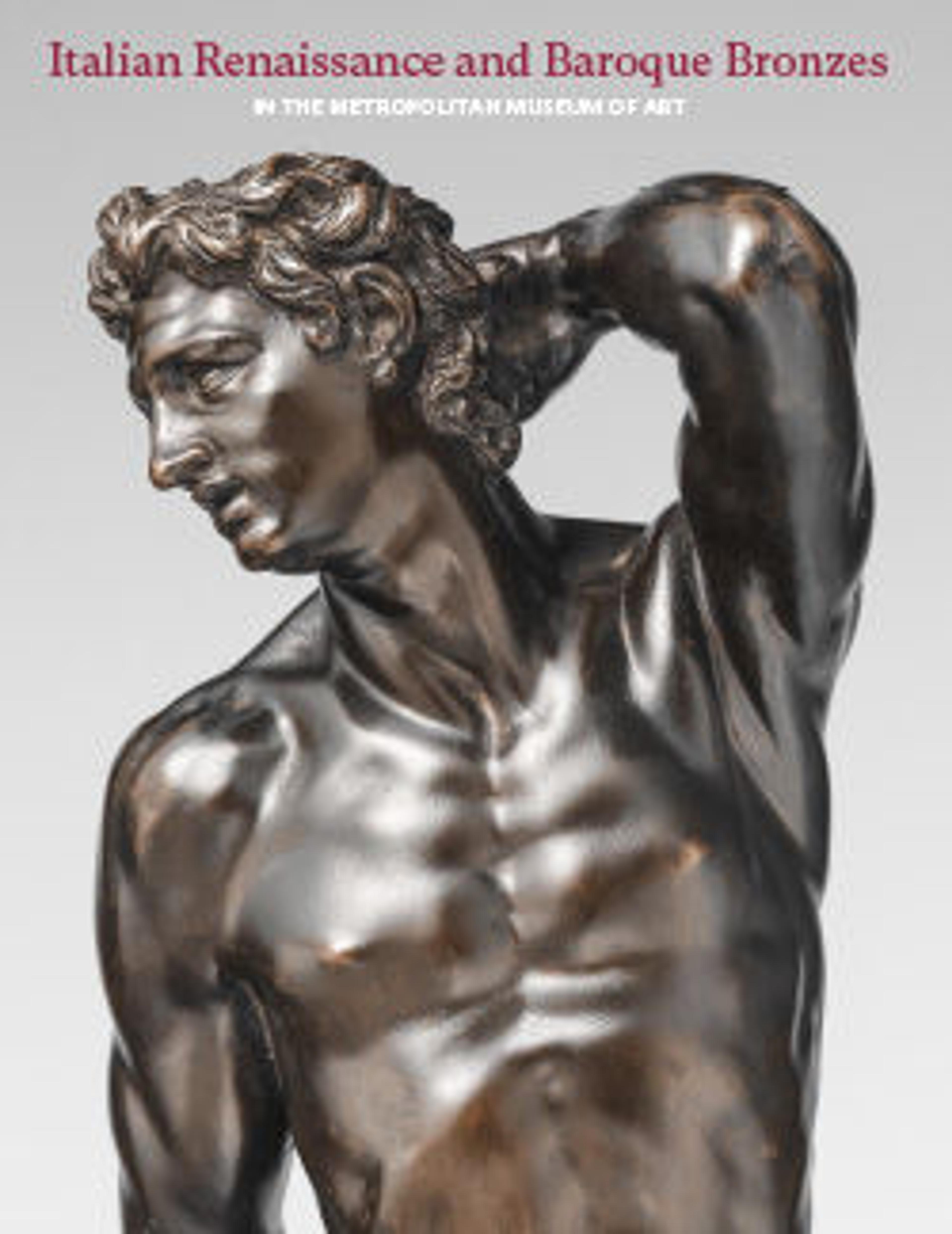Venus chastening Cupid
The bronze represents the scene of Venus Chastening Cupid, in which the god of love is bound to a tree and scourged. It has been convincingly argued that the subject was inspired by a passage from Giambattista Marino’s famous Adone (published in Paris in 1623), although the mythological story goes back to a fourth-century eclogue by Ausonius, In qua Cupido cruciatur.[1] Our group is a replica of a composition by the Florentine sculptor Giovanni Francesco Susini.[2] He executed two signed and dated versions: the first in 1638 for Karl Eusebius von Liechtenstein; the second in 1639, bequeathed to Louis XIV by André Le Nôtre and now in the Louvre (fig. 139a).[3] Both are 58.2 cm in height, and each recurs as a pendant with a bronze Venus Burning Cupid’s Arrows. Although the themes of the disarming and punishment of Cupid are complementary, the two groups were not necessarily modeled together. A number of copies have circulated on the art market.[4] The Met’s cast might be the one published in the 1919 catalogue of the Canessa collection, but no evidence has surfaced to confirm this.[5]
Given its dimensions, our Venus Chastening Cupid appears to be a very late replica of the signed Liechtenstein bronze. Conspicuous variations point to a nineteenth-century production, particularly the unhappy addition of a cache-sexe, a sop to the moralizing temperament of later bourgeois buyers. This device is also present on the Venus Chastening Cupid formerly in the collection of Prince Nicholas of Romania, a cast inscribed “Firenze MDLXXXIII.”[6] This inscription was either misread or forged, as 1583 would be too early for the invention of this model.[7] Like many versions on the market, ours has a rather ponderous base, a reelaboration of Susini’s model probably intended to provide more stability. The two figures and the base were all cast separately and are of considerable weight.[8]
-FL
Footnotes
(For key to shortened references see bibliography in Allen, Italian Renaissance and Baroque Bronzes in The Metropolitan Museum of Art. NY: The Metropolitan Museum of Art, 2022.)
1. Maclagan 1920, p. 240.
2. The model was attributed to Alessandro Vittoria in Canessa 1919, no. 284.
3. Princely Collections of Liechtenstein, Vienna, SK542; see Montagu 1963, p. 89. For the Louvre bronze, see Draper in New York 1985, pp. 74–75, cat. 43; Paris 1999, p. 133, cat. 190.
4. Sotheby’s, London, December 12, 1996, lot 00093; Christie’s, Paris, November 17, 2009, lot 00457 (ca. 1700–1799; perhaps the same bronze auctioned in 1996); Christie’s, New York, October 22, 2010, lot 00589 (with Venus Burning Cupid’s Arrows; ca. 1875–99); Christie’s, South Kensington, January 29, 2013, lot 00071 (pair; 19th century); Thierry de Maigrait, June 5, 2013, lot 00058 (ca. 1800–1825; the same pair auctioned on January 29).
5. See note 2.
6. Galerie Stuker, Bern, May 21–30, 1964, lot 3402; see Lombardi 1979, p. 763 n. 14.
7. Draper in New York 1985, p. 75.
8. R. Stone/TR, February 1, 2011.
Given its dimensions, our Venus Chastening Cupid appears to be a very late replica of the signed Liechtenstein bronze. Conspicuous variations point to a nineteenth-century production, particularly the unhappy addition of a cache-sexe, a sop to the moralizing temperament of later bourgeois buyers. This device is also present on the Venus Chastening Cupid formerly in the collection of Prince Nicholas of Romania, a cast inscribed “Firenze MDLXXXIII.”[6] This inscription was either misread or forged, as 1583 would be too early for the invention of this model.[7] Like many versions on the market, ours has a rather ponderous base, a reelaboration of Susini’s model probably intended to provide more stability. The two figures and the base were all cast separately and are of considerable weight.[8]
-FL
Footnotes
(For key to shortened references see bibliography in Allen, Italian Renaissance and Baroque Bronzes in The Metropolitan Museum of Art. NY: The Metropolitan Museum of Art, 2022.)
1. Maclagan 1920, p. 240.
2. The model was attributed to Alessandro Vittoria in Canessa 1919, no. 284.
3. Princely Collections of Liechtenstein, Vienna, SK542; see Montagu 1963, p. 89. For the Louvre bronze, see Draper in New York 1985, pp. 74–75, cat. 43; Paris 1999, p. 133, cat. 190.
4. Sotheby’s, London, December 12, 1996, lot 00093; Christie’s, Paris, November 17, 2009, lot 00457 (ca. 1700–1799; perhaps the same bronze auctioned in 1996); Christie’s, New York, October 22, 2010, lot 00589 (with Venus Burning Cupid’s Arrows; ca. 1875–99); Christie’s, South Kensington, January 29, 2013, lot 00071 (pair; 19th century); Thierry de Maigrait, June 5, 2013, lot 00058 (ca. 1800–1825; the same pair auctioned on January 29).
5. See note 2.
6. Galerie Stuker, Bern, May 21–30, 1964, lot 3402; see Lombardi 1979, p. 763 n. 14.
7. Draper in New York 1985, p. 75.
8. R. Stone/TR, February 1, 2011.
Artwork Details
- Title:Venus chastening Cupid
- Artist:Giovanni Francesco Susini (Italian, Florence 1585–1653 Florence)
- Date:Late 19th century
- Culture:Italian, Florence
- Medium:Bronze
- Dimensions:Overall (confirmed): 22 1/2 × 12 5/8 × 8 5/8 in. (57.2 × 32.1 × 21.9 cm)
- Classification:Sculpture-Bronze
- Credit Line:Bequest of Annie C. Kane, 1926
- Object Number:26.260.90
- Curatorial Department: European Sculpture and Decorative Arts
More Artwork
Research Resources
The Met provides unparalleled resources for research and welcomes an international community of students and scholars. The Met's Open Access API is where creators and researchers can connect to the The Met collection. Open Access data and public domain images are available for unrestricted commercial and noncommercial use without permission or fee.
To request images under copyright and other restrictions, please use this Image Request form.
Feedback
We continue to research and examine historical and cultural context for objects in The Met collection. If you have comments or questions about this object record, please contact us using the form below. The Museum looks forward to receiving your comments.
